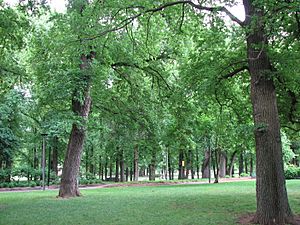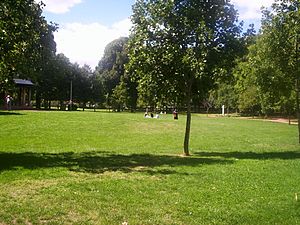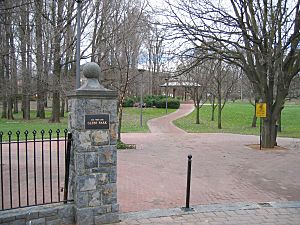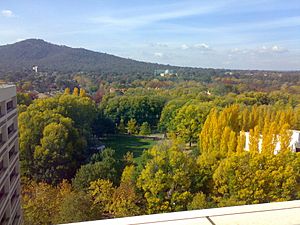Glebe Park, Canberra facts for kids
Glebe Park is a public park located on the eastern side of Civic, which is part of Canberra, Australia. The park is surrounded by Coranderrk, Ballumbir, Akuna, and Bunda Streets. To the south, you'll find the National Convention Centre.
Contents
Discovering Glebe Park's Past
Glebe Park used to be part of a much larger piece of land, about 40 hectares (100 acres) in size. This land was given to the Anglican Church in the early 1840s by a man named Robert Campbell. It was used as a "glebe," which means land that helps provide money for the church's expenses.
At the same time, Robert Campbell also gave a smaller piece of land, about 8,000 square meters (two acres), to St John the Baptist Church in nearby Reid.
The Old Rectory and Its Trees
Between 1871 and 1873, a house called Glebe House was built. It served as the rectory, or home, for the rector (a type of priest) of St John's church. This two-story house was made from bricks from local clay. The land around it was used as a farm to help support the rector.
The Reverend Pierce Galliard Smith was the rector at St John's for a very long time, from 1855 to 1906. He planted many trees around the house, including elms, willows, and poplars. Many of the elm trees you see in the park today are descendants of his original plantings, with some even being over a hundred years old!
Today, there are nearly 700 trees in the park. More than 500 of these are English elms, and about 100 are English oaks.
Changes Over Time
In 1912, when Canberra was chosen to be Australia's capital city, the government took over the land and building. However, it continued to be used as a rectory until 1926.
After that, Glebe House became a guest house for about 25 years. By 1954, the house was in poor condition and didn't fit with the city's plans for development. Despite some people wanting to save the historic building, it was eventually sold. The bricks from the house were used to build a clubhouse for a football team. Later, a plaque was placed nearby to mark where the old building once stood.
Glebe Park Today
In the 1980s, people in the community worked hard to save the park's beautiful trees. Their efforts led to the area being officially named a park in 1983. It was also listed as a heritage site, meaning it's important to protect its history and nature.
In 1989, the park got a makeover with new fences, gates, paths, a rotunda (a round building with a dome-shaped roof), and a playground. The park has ten gates, each named after important historical people or places. During this time, some land was also used for building the National Convention Centre Canberra, a casino, and a hotel. Today, Glebe Park is about 4.7 hectares (just under 12 acres) in size.
Fun Things to Do in the Park
Glebe Park is a great place for families! It has a fun children's playground where kids can play.
The park also hosts outdoor art exhibitions, especially during the Canberra Festival. In 2017, the Canberra Christmas celebrations moved to Glebe Park, offering a family-focused event for several weekends and supporting a charity called Red Nose.
Images for kids
-
The park's deciduous trees lose their leaves in winter and provide strong autumn foliage colour










